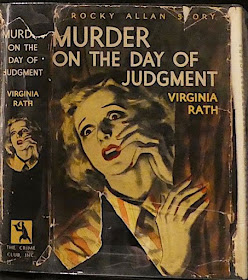THE CHARACTERS: Gordon Knollis is the detective created by Francis Vivian and he's one of the more interesting of the humanistic detectives. He treats everyone with decency and compassion though he may tend to lose his patience with reckless drivers like young Sir Giles. The Threefold Cord (1947) is his third case and proves to be both macabre and puzzling. Undaunted by the odd clue of the blue ribbons and the prelude of the pet slaughter Knollis quickly gets to the bottom of a murder case that stems from someone's haunted and scandalous past. He's a detective who stands out as a real hero as well as a fine sleuth and he makes the book all the more exciting for his presence.
Among the suspects are a trio of servants (chauffeur, maid and cook/housekeeper) who unlike in most of the formulaic whodunnits of this era are not relegated to the background or offered up as comic archetypes. Rather all three are integral to the plot and solution of the various crimes. The maid, who is in love with the chauffeur, provides some crucial eyewitness testimony and evidence that help Knollis discard some theories and lead him to the correct culprit. Also a stand out is the haughty actress Dana Vaughan, who puts to shame some of Christie's finely drawn actor/actress characters in terms of ego and vanity. Miss Vaughan is starring in a psychological thriller called The Hempen Rope and it will feature prominently in the solution of the crime. Strangulation also occurs in that play. Vaughan is so intense an actress, and the role so torturous to perform, that she suffers from sleepwalking episodes during which she reenacts the strangling scenes. The latest such unexpected victim of one of her "spells" was her dresser at the theater. The play, Knollis will discover, is also coincidentally based on true life and borrows heavily from the past life of one person among the list of suspects in Manchester's murder.
INNOVATIONS: Though nothing really stands out as innovative Francis Vivian's plotting is intricate and his storytelling talent is remarkable for being humorous, engaging and a challenge to any reader who likes to match wits with the fictional detective. Fair play clueing is competent if not stellar or ingenious. Vivian's strengths are his characters and his lively wit, something I think that most detective novels are lacking in and an aspect of mystery fiction I find more and more to be almost imperative.
QUOTES: "You ask very impertinent questions, Inspector."
Knollis nodded as he turned to the door. "Yes, Miss Vaughan, but you must remember that Death has no manners as a general rule. In this instance he was a reformed character, and knocked twice before entering."
"When I left the station I was astounded by the way in which Londoners rushed about, as if the bus coming up the road, or the Tube train coming out of the tunnel, was the last one for hours instead of the last one for two minutes. I felt sorry for them allowing themselves to be caught up in such an idiotic race. Two days later I discovered myself running down an escalator to catch a train that wasn't even signalled in. Silly, isn't it? One sheep goes though the gap in the hedge, and all the others follow. There's a moral in it somewhere."
"Yes. I'm afraid that the human race is more notorious for its stupidity than for anything else. [...] We seem to be rushing to destruction as fast as our legs can take us."
 |
| Ebenezer Cobham Brewer, from a frontispiece in a later edition of his famed work |
EASY TO FIND? Yes, indeed! (Aren't those two lovely words to read in this section?) In fact, in three days you can buy as many Inspector Knollis mystery novels as you want because all ten of them have been reprinted by the estimable Dean Street Press. And I'm sure that all of them contain a knowledgeable foreword by Curt Evans chockful of all sorts of biographical nuggets on the author and critical insights into the Knollis series. I checked the US amazon site and so far all of these books are available in a Kindle edition, but I found only a few in paperback editions for purchase in the US. If you live in the US I'd recommend going to Book Depository to get a paperback edition. All ten titles are available there as print books and they have free shipping at all times. The prices on Book Depository also often tend to be cheaper than amazon sometimes as much as five dollars less.
I've purchased three of these reprints and am eagerly awaiting their arrival in my home. In the meantime I'm preparing a review of the penultimate Knollis mystery Darkling Death for a post to be published in October. Stay tuned for more about Inspector Knollis and crew!
Gordon Knollis Detective Novels
The Death of Mr. Lomas (1941)
Sable Messenger (1947)
The Threefold Cord (1947)
The Ninth Enemy (1948)
The Laughing Dog (1949)
The Singing Masons (1950)
The Elusive Bowman (1951)
The Sleeping Island (1951)
The Ladies of Locksley (1953)
Darkling Death (1956)
Dead Opposite the Church (1959)*
*(not a central character)














